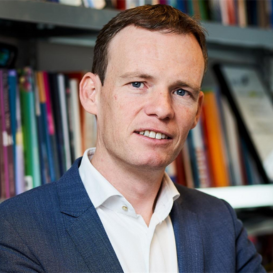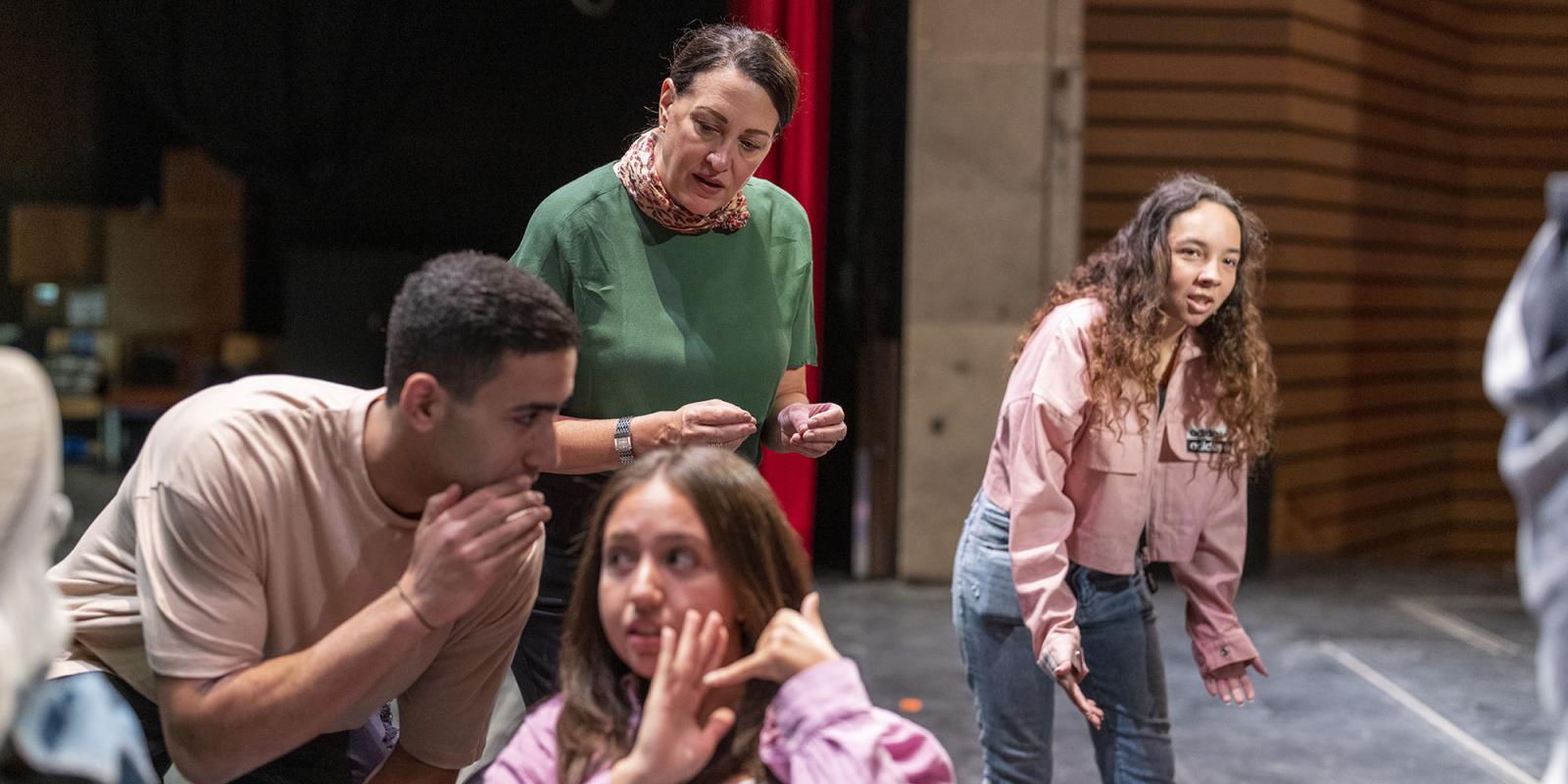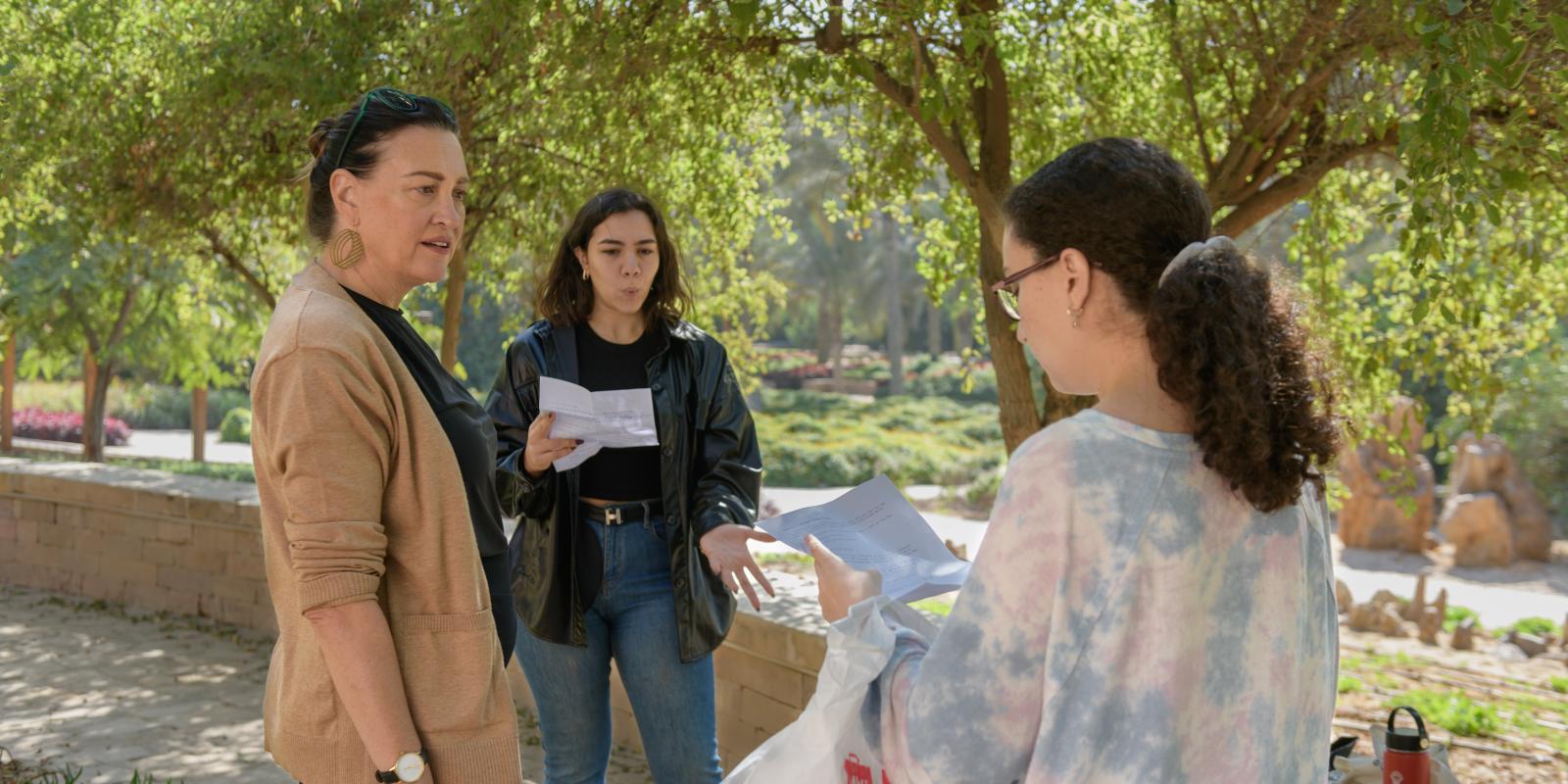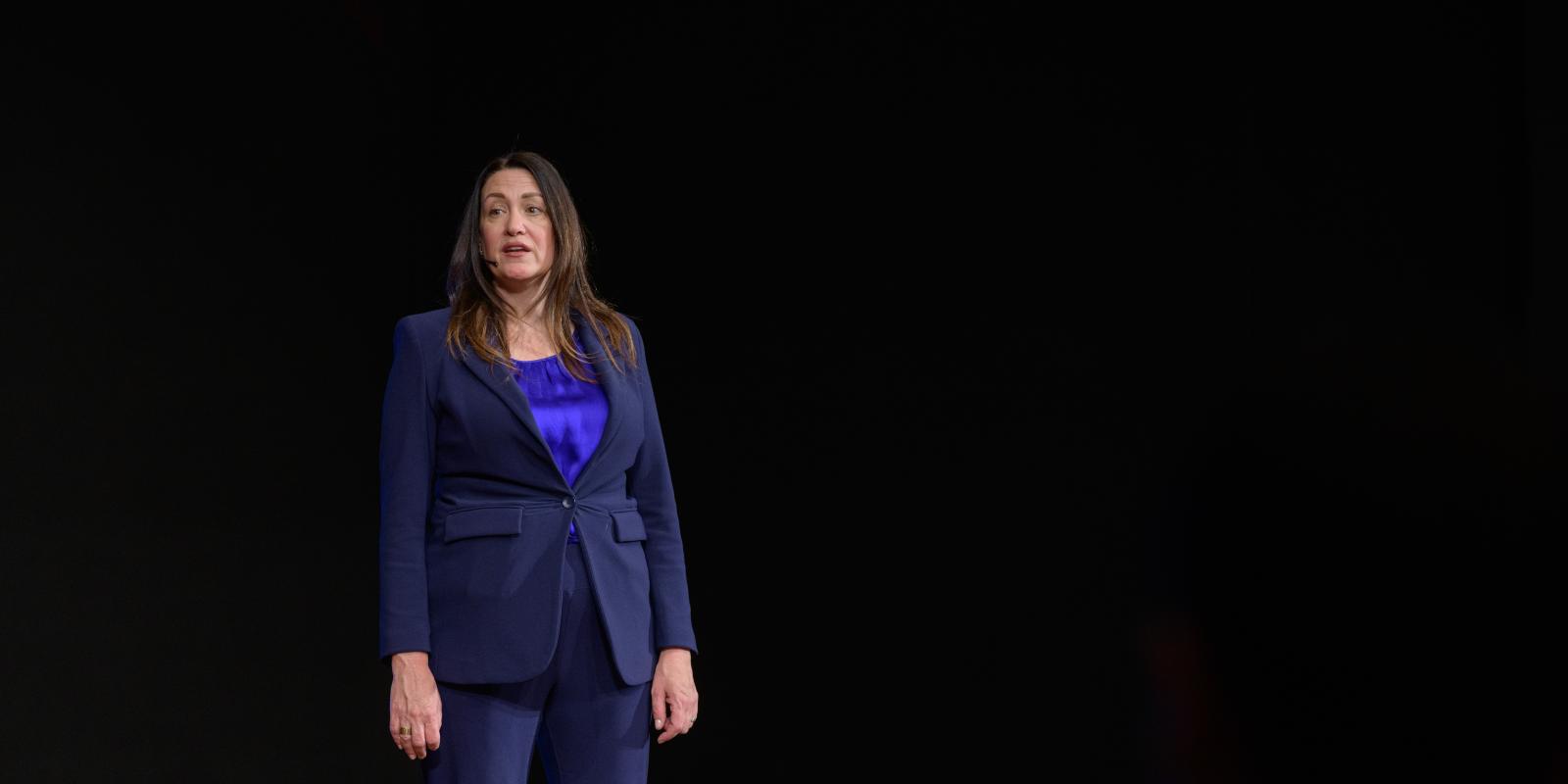
The Politics of Migration and Diversity: European Approaches in a Global Perspective.
Discover European strategies for managing migration and diversity in a global context featuring Peter Scholten of Erasmus University Rotterdam.
With a specialization in cognitive science, Jacquelyn Berry, assistant professor in the Department of Psychology has launched Egypt’s first experimental psychology laboratory at AUC, where students, faculty and staff study attention, perception, memory, learning and language using computer- and eye-tracking technology.
“When people think of psychology, they tend to focus on everything that goes wrong with the brain –– depression, anxiety and typical disorders –– that they take for granted everything that goes right like all of the amazing things we do every day, from split-second decisions when driving a car or handling multiple tasks at once,” says Berry. “Our brain is juggling so much information, and we only notice when things go wrong because the brain gets it right 99% of the time.” That’s why visual illusions and 3D movies are so much fun because, somehow, we can trick this amazingly reliable organ.”
Having launched just last year, the lab has already been home to half a dozen studies and hosted more than 100 experimental participants. Berry has approximately one dozen research assistants in the lab at any given semester, including graduate and undergraduate students. “Everyone gets enriched,” Berry explains. “Students get hands-on experience conducting research, participants usually get some bonus credit towards their classes and anyone involved is exposed to the unique research we are doing at AUC.
With help from the lab’s assistants and collaborating with other Egyptian universities, Berry organized the inaugural Cognitive Screening and Cognitive Interventions in Egypt conference, which was held at AUC in Fall 2023 and focused on training Egypt-based medical professionals, from psychologists to neurologists, in cognitive screening and neuropsychological intervention strategies. The conference featured speakers from four different continents, including Dr. Nasser Loza, president of the World Federation for Mental Health, and Dr. Ziad Nasreddine, president of MoCA Cognition, Health Tech who developed the test used by the White House to assess mental fitness. “The conference examined how we can modify the tests conducted in Western populations for the Egyptian population; we’re getting there,” says Berry,
Eyes as Windows to the Soul
Berry’s research approach is unique as she employs video games to observe cognitive functions through computer-based tasks and the video game Tetris. The game she employs in her research collects more than 100 different underlying metrics to measure human performance, including eye-tracking.
First joining AUC as a Fulbright U.S. Scholar in 2019, Berry researched Arabic-English biliteracy and how this affects switching between different technology interfaces. “Now we're looking at AI and how that can shorten the learning curve, where people go from not knowing how to do something to being an expert at it and all the different stages in between. My research examines if we can jump that curve a little bit with the help of AI learning tools. That's what I've been doing with Tetris.”
But aren’t video games bad for children? Berry has a different argument.
“Certain types of video games enhance cognitive function, specifically first-person shooters because they boost attention. Something happens when you motivate people toward a goal,” she says. “Understandably, people worry about violence in video games, but kids do get smarter and their attention gets better. There is even evidence that ADHD can be treated using video games and Tetris is known to prevent post-traumatic stress disorder. Of course, everything has to be in moderation.”
With the eye-tracking technology at AUC’s experimental psychology lab, Berry can closely trace what's happening in the brain from an executive function perspective.
“Take Arabic-English speakers, for example,” says Berry. “If you’re a native Arabic speaker and you're speaking to me in English, you're actively suppressing Arabic because you know that I'm not going to understand it very well. But if you go home and spend time with, say, your grandparents, you're going to suppress all the English that you use. That ability to suppress one language and use the other is what we call executive function, and it affects the way we process information and manage everything we do. People with high executive function are better at all tasks related to inhibiting things they don't need right now. It’s also protection against dementia. So bilingual speakers are less likely to develop Alzheimer’s disease when they get older.”
The eye-tracking technology at the lab provides other unique insights. “By looking at someone's pupils, you can see how much cognitive load they're under,” Berry explains. “If an expert sees something they have experience with, their pupils aren't going to dilate as much as someone new at it. The eyes are indeed the windows to the soul.”
Moving forward, Berry hopes that the lab will draw in people of all ages for testing. “My goal is to increase our sample population so we can better understand cognitive functions across age groups,” she says. “I want to continue with high-level eye-tracking research to enhance our baseline tests on cognitive functions, such as the types of tests we use to uncover dementia and Alzheimer's; and take our AI research to the next level to understand how people learn new tasks, both in Tetris and outside of Tetris.”
Want to get involved? Send an email to [email protected].

Bernard O'Kane, professor of Islamic art and architecture, received Iran's World Book of the Year Award –– the most prestigious in the country –– for his rich and exquisitely photographed volume, Studies in Persian Architecture (2021).
O'Kane received the same award in 2004 for his book, Early Persian Painting: Kalila and Dimna Manuscripts of the Late Fourteenth Century (2003).
“I’m delighted to receive the award again,” said O’Kane. “The first was for a book on Persian manuscript paintings; this is on a very different aspect of my research, Persian architectural history.”
Through Studies in Persian Architecture, O'Kane presents 300 photographs, mostly his own, previously unpublished in color and 25 of his articles dissecting Persian monuments as well as prime features of Iranian architecture.
“The collected article series of Edinburgh University Press (this is one of three published simultaneously) gave me a chance to revise previously published articles and to update them by substituting color photos of earlier black and white ones. We also added an index to each one, making it much more user-friendly,” explained O’Kane.
The book examines the monuments of the Greater Persian world, from Iraqi to Chinese borders, including buildings from historic periods that have rarely been studied by scholars. Each monument is placed within its relevant social and political context, with an analysis of historiography, tilework, development of the domes of Iranian mosques and more. Buildings include those of the main medieval dynasties –– the Seljuqs, Ilkhanids and Timurids –– in addition to previously neglected ones, such as Uzbek monuments in Afghanistan and those of the Chaghatai, Muzaffarid, Kartid and Jalayirid dynasties.
“Persia has a particularly rich architectural heritage with the monuments, unlike Egypt, not being concentrated in one capital city but spread out to include all of Iran’s neighbors,” said O’Kane, highlighting his interest in Persian architecture. “The art of tilework was continuously developed there from the 12th century onward, and their use of bright but carefully controlled tiled facades is a joy to behold.”
A prolific author, avid photographer and AUC faculty member for the past 44 years, O’Kane has published numerous books, most recently Mosques: The 100 Most Iconic Islamic Houses of Worship (2019) and The Mosques of Egypt (2017).
Why Islamic art and architecture? “The vast range of Islamic architecture, from Andalusia to Indonesia, is both a delight and a challenge,” said O’Kane. “The centrality of the hajj meant opportunities for patrons and craftsmen to travel, and it is fascinating to see how this played out in architectural styles of sometimes widely separated areas.”

Estimated to affect more than 90% of Egyptian women and 1 in 3 women worldwide, sexual harassment is an experience that an unconscionable amount of people share. A global issue, Jillian Campana, theatre professor and associate dean for undergraduate studies at AUC’s School of Humanities and Social Sciences, explores how sexual violence is addressed in Egypt and the United States in order to better understand effective education, support systems and forms of redress.
Addressing sexual violence in both countries highlights challenges that intersect cross-culturally. “The question we tackled was, ‘How different are we?’ and the answer we arrived at was ‘Not very different at all,’' says Campana. “Our cultures are very distinct, but the reasons why people commit crimes of sexual violence and the ways that they’re addressed are incredibly similar. They may appear different because of culture and legislation, but the dynamics are parallel.”
Campana's work in both the United States and Egypt has had an impact on and off stage, exploring using performance to help individuals process and heal from trauma. Her projects have included a 12-year research effort helping brain injury survivors rewire neural pathways via movement and speech exercises, working with U.S. military veterans to use playwriting to navigate post-traumatic stress disorder, and a creative research project in India and the Philippines helping survivors of sexual trafficking build skills for the workplace. Her work as a professor at the University of Montana included using theatre as a tool for anti-sexual harassment training, and she was a faculty mentor to actress Lily Gladstone, winner of a Golden Globe Award, as she studied theatre and social justice.
Recently honored by Times Higher Education for the Msh Zanbik project, Professor Jillian Campana examines cross-cultural differences in sexual harassment education, focusing on Egypt and the United States, and the importance of theatre as a powerful medium to invoke change and heal from trauma.

When it comes to education and effectively addressing sexual violence, the importance of cultural context and language can’t be overstated.
“There’s this very powerful play called The Wolves by American playwright Sarah DeLappe about a female college soccer team navigating teen girlhood, including experiences with sexual violence. I first thought about performing this show at AUC. But it doesn't work at all — nothing that happens in that play fits our context,” Campana says.
While trying to navigate how they could adjust The Wolves to resonate with AUC, Campana and her students quickly realized that it wouldn’t work to adapt something created for a completely different environment and culture. Unable to find an alternative, it became clear there was a gap that needed to be addressed. “There were very limited resources on sexual violence: There’s a high-profile film called 678 and a few educational videos made for workplaces, but overall, there’s a pronounced lack of nuanced information, especially in Arabic,” Campana says.
This led to the formation of Msh Zanbik, a research project led by Campana and Dina Amin ‘84, associate professor and director of the theatre program, that culminated in a collection of short plays written by students. Wrestling with topics surrounding sexual violence grounded in an Egyptian context, the plays were produced in both Arabic and English and performed at AUC.
The plays hold the potential for a wide impact: released royalty-free, Campana hopes they will be dispersed, examined, discussed, reimagined and tailored to suit whatever context they’re performed in.
“Through being involved with Msh Zanbik, students are identifying and examining dynamics around sexual violence in a way that helps them prepare for encountering these situations,” Campana says.

The involvement of students — placing the definitions and conversations in their hands — is crucial in localizing resources and making anti-sexual violence initiatives effective. “You can make students participate in hegemonic anti-sexual violence trainings, but it’s proven to be inneffective,” Campana says. “A lot of the training isn’t relevant to their context because it’s not coming from the students themselves who have the lived experience and are the experts on what it looks like in their communities. They need to be supported in defining the problem themselves.”
With this goal in mind, Campana also worked with students and the Office of Institutional Equity and Title IX Director Reem El-Mograby ‘09 to produce three short videos in Arabic and English to be used by the Office of Institutional Equity as tools for anti-sexual harassment training. The videos involved students, alumni, staff and faculty, focusing on educating students about defining sexual harassment, making a difference in their communities and empowering them to report issues. The videos also seek to capture some of the more subtle forms of sexual harassment like staring, seemingly friendly and casual touch and second hand comments. Most students will see these videos as part of their freshman year orientation, followed by smaller group discussions to contextualize the scenarios.
"I am very proud that AUC has taken the lead in this area. There is not a single college or university that is immune to this issue and it takes courage to lead this conversation and to lead it in this region," Campana adds.

Msh Zanbik was awarded the Research Project of the Year: Arts, Humanities and Social Sciences award from Times Higher Education, a feat which, for Campana, highlights the University’s role as a leader in the region when it comes to teaching about sexual violence. “It also reinforces the arts as a powerful medium to invoke change and theatre as an opportunity to rehearse for reality. We can practice behaviors, ways of thinking and language in what is a bit of a liminal space and eventually go out into the real world and apply what we’ve learned there,” Campana says.
Campana hopes that with time and projects like Msh Zanbik, more people in Egypt and beyond will be informed and empowered when it comes to sexual violence, helping to mitigate social barriers to accessing institutional support that regulations can’t address, like stigma and retaliation.
“Theatre is a community event, and these conversations need to be happening publicly,” Campana says. “It’s important for everyone to get involved however they can and become the experts on addressing this in their own context and community.”
To seek support regarding or report experiences of sexual harassment and assault on campus, visit the Office of Institutional Equity's webpage.
